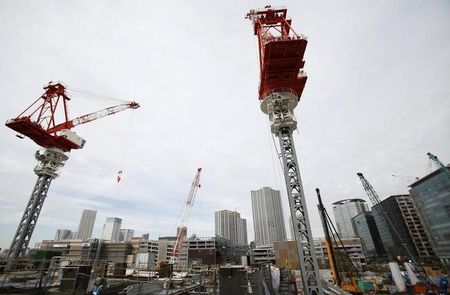By Tetsushi Kajimoto
TOKYO (Reuters) - Japan's leading gauge of capital spending rose for a third straight month in August, in a tentative sign firms are investing their profits in plants and equipment that could bolster growth in the world's third-largest economy.
But analysts say the 4.7 percent gain in core machinery orders is not enough to dispel concerns the economy is losing traction even as the Bank of Japan keeps ultra-loose monetary policy and the government stands ready to deploy fresh stimulus.
A sales tax hike that went into effect in April triggered the deepest economic slump in the April-June quarter since the 2008-09 global financial crisis.
The data followed a shocking slump in August factory output and other soft indicators including exports and household spending, complicating the government's decision by the year-end on whether to proceed with a second sales tax hike next year.
"Today's data in itself is positive as it confirms steady capital spending," said Takeshi Minami, chief economist at Norinchukin Research Institute.
"But companies remain far from being assured about the outlook. If consumption and factory output remain sluggish, that could force them to revise down their capital spending plans."
Minami added that a weak yen
Prime Minister Shinzo Abe is due to make a decision on the sales tax increase in December, looking at economic indicators in July-September for clues on whether the economy is strong enough to withstand the impact from the higher levy.
The government plans to increase the sales tax rate to 10 percent in October 2015, after having raised it to 8 percent from 5 percent in April.
Cabinet Office data showed core machinery orders, a highly volatile data series regarded as a key gauge of capital spending in six to nine months, rose 4.7 percent in August from the prior month, much faster than a 0.9 percent gain expected by analysts.
"Machinery orders show a moderate pick-up move," the Cabinet Office said, upgrading their assessment. Previously, machinery orders were described as seesawing.
The rise followed monthly gains of 3.5 percent in July and 8.8 percent in June, after a record 19.5 percent drop in May.
While manufactures' orders fell 10.8 percent in reaction to a big gain in July, non manufacturers' orders rose 10.7 percent, helped by a big order for battery chargers at a leasing sector.
Compared with a year earlier, core orders, which exclude ships and power utilities, fell 3.3 percent in August, versus a 5.1 percent decline seen by economists, it showed.
The Japanese economy shrank an annualised 7.1 percent in the second quarter, the biggest contraction since early 2009, as the April tax hike dealt a heavy blow to consumer demand.
With exports and private consumption both lacking momentum, policymakers hope firms capitalise on higher profits to boost investment and raise wages to generate a virtuous economic cycle and sustain growth in the broader economy.
The Bank of Japan's key tankan corporate survey showed last week that big firms expect to raise capital expenditure by a more-than-expected 8.6 percent in the current fiscal year to March.

The BOJ on Tuesday stuck to its monetary stimulus and view that the economy is continuing to recover moderately, while noting weakness in factory output, as firms are saddled with inventories of unsold cars and electronics.
(Editing by Jacqueline Wong)
